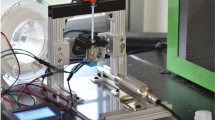Abstract
The injection molding process is one of the most efficient processes where mass production through automation is feasible and products with complex geometry at low cost are easily attained. In this study, an experimental work is performed on the effect of injection molding parameters on the polymer pressure inside the mold cavity. Also, the effect of these parameters on the final products' weight is studied. Different process parameters of the injection molding are considered during the experimental work (packing pressure, packing time, injection pressure, injection time, and injection temperature). Two polymer materials are used during the experimental work (polystyrene (PS) and low-density polyethylene (LDPE)). The mold cavity has a cuboidal form with two different thicknesses. The cavity pressure is measured with time by using pressure Kistler sensor at different injection molding cycles. The results indicate that the cavity pressure and product weight increase with an increase in the packing pressure, packing time, and injection pressure for all the analyzed polymers. They also show that the increase of the filling time decreases the cavity pressure and decreases the product weight in case of PS and LDPE. The results show that the increase of packing pressure by 100 % increases the cavity pressure 50 % in the case of PS and 70 % in the case of LDPE. They also show that the increase of injection pressure by 60 % increases the cavity pressure 36 % in case of PS and 90 % in case of LDPE at an injection temperature of 220 °C. The results indicate that process parameters have an effect on the product weight for LDPE greater than PS. The results obtained specify well the developing of the cavity pressure inside the mold cavity during the injection molding cycles.
Similar content being viewed by others
References
Min BH (2003) A study on quality monitoring of injection-molded parts. J Mater Process Technol 136:1–6
Tang SH, Kong YM, Sapuan SM, Samin R, Sulaiman S (2006) Design and thermal analysis of plastic injection mould. J Mater Process Technol 171:259–267
Crawford RJ (1987) Rubber and plastic engineering design and application. Applied, London, p 110
Hassan H, Regnier N, Le Bot C, Defaye G (2010) 3D study of cooling system effect on the heat transfer during polymer injection molding. Int J Therm Sci 49:161–169
Bozdana AT, Eyercıoglu O (2002) Development of an expert system for the determination of injection moulding parameters of thermoplastic materials: EXPIMM. J Mater Process Technol 128:113–122
Tsai KM, Hsieh C, Chun Lo W (2009) A study of the effects of process parameters for injection molding on surface quality of optical lenses. J Mater Process Technol 209:3469–3477
Hassan H, Nicolas RN, Defaye G (2009) 3D study on the effect of process parameters on the cooling of polymer by injection molding. J Appl Polym Sci 114:2901–2914
Huang MS (2007) Cavity pressure based grey prediction of the filling-to-packing switchover point for injection molding. J Mater Process Technol 183:419–424
Wei W-CJ, Rong-Yuan W, Ho S-J (2000) Effects of pressure parameters on alumina made by powder injection moulding. J Eur Ceram Soc 20:1301–1310
Yan SY, Lien L (1996) Experimental study of injection compression molding of cylindrical parts. Adv Polym Proc 15(3):205–223
Zhang JG, Edirisinghe MJ, Evans RG (1989) The control of sprue solidification time in ceramic injection moulding. J Mater Sci 24:840–848
Kostic B, Zhang T, Evans RG (1993) Effect of molding, condition on residual stresses in powder injection molding. Int J Powder Metall 29(3):251–257
Mehdi Rafizadeh W, Patterson I, Kamal MR (1999) Physically-base adaptive control of cavity pressure in injection moulding process: packing phase. Iran Polym J 8(2):1226–1265
Kurt M, Kamber OS, Kaynak Y, Atakok G, Girit O (2009) Experimental investigation of plastic injection molding: assessment of the effects of cavity pressure and mold temperature on the quality of the final products. Mater Des 30:3217–3224
Le Cuong M, Belhabib S, Nicolazo C, Vachot P, Mousseau P, Sarda A, Deterre R (2011) Pressure influence on crystallization kinetics during injection molding. J Mater Process Technol 211:1757–1763
Angstadt DC, Coulter JP. Cavity pressure and part quality in the injection molding process. Intell Mater Manuf Lab. Lehigh University, Pennsylvania, USA
Hassan H (2010) Heat transfer during injection molding. LAP Lambert Academic, AG & Co. KG, Sarrebruck, Allemagne
Akbarzadeh A, Sadeghi M (2001) Parameter study in plastic injection molding process using statistical methods and IWO algorithm. Int J Model Optim 1(2):141–145
Varela AE (2000) Self tuning pressure control in an injection moulding cavity during filling. Chem Eng Res Des 78(1):79–86
Hang X, Zhou C (1999) Post filling analysis of viscoelastic polymers with a structure parameter. Polym Eng Sci 39(11):2313–2323
Shojaeia A, Ghaffarianb SR, Karimianc SMH (2003) Simulation of the three-dimensional non-isothermal mold filling process in resin transfer molding. Compos Sci Technol 63:1931–1948
Leo V, Cuvellez C (1996) The effect of the packing parameters, gate, geometry, and mold elasticity on the final dimensions of a molded part. Polym Eng Sci 36(15):1961–1971
Jansen KMB, Van Dijk DJ, Husselman MH (1998) Effect of processing conditions on shrinkage in injection. Polym Eng Sci 38:838–846
Papathansiou TD (1995) Modeling of injection mold filling: effect of under cooling on polymer crystallization. Chem Eng Sci 50(21):3433–3442
Boldizar A, Kubat J (1986) Measurements of cycle time in injection molding of filled thermoplastics. Polym Eng Sci 26(12):877–885
Author information
Authors and Affiliations
Corresponding author
Rights and permissions
About this article
Cite this article
Hassan, H. An experimental work on the effect of injection molding parameters on the cavity pressure and product weight. Int J Adv Manuf Technol 67, 675–686 (2013). https://doi.org/10.1007/s00170-012-4514-4
Received:
Accepted:
Published:
Issue Date:
DOI: https://doi.org/10.1007/s00170-012-4514-4




